|
|
|
|
Sioux Tribe
A confederation of Native North American tribes, the dominant group of the Hokan-Siouan linguistic stock, which is divided into several separate branches. The Sioux, or Dakota, consisted of seven tribes in three major divisions: Wahpekute, Mdewakantonwan, Wahpetonwan, Sisitonwan (who together formed the Santee or Eastern division, sometimes referred to as the Dakota), the Ihanktonwan, or Yankton, and the Ihanktonwana, or Yanktonai (who form the Middle division, sometimes referred to as the Nakota), and the Titonwan, or Teton (who form the Western division, sometimes referred to as the Lakota). The Tetons, originally a single band, divided into seven sub-bands after the move to the plains, these seven including the Hunkpapa, Sihasapa (or Blackfoot), and Oglala.

Sioux Chief Running Antelope is the only Native American whose portrait is featured on American Currency. Portraying the Chief in a Pawnee headdress, rather than his Sioux tribal headdress, created a political scandal. This insensitive portrayal of Chief Running Antelope created additional ill will between the Pawnee and the Sioux tribes. Migration toward the Southwest
The Sioux were first noted historically in the Jesuit Relation of 1640, when they were living in what is now Minnesota. Their traditions indicate that they had moved there some time before from the northeast. They were noted in 1678 by the French explorer Daniel Duluth and in 1680 by Father Louis Hennepin in the Mille Lacs region in Minnesota. Their migration had been in a southwesterly direction in the face of the hostile Ojibwa, who had been equipped with guns by Europeans.
In the mid-18th cent., having driven the Cheyenne and Kiowa out of the Black Hills, the Sioux inhabited the N Great Plains and the western prairiesmainly in Wisconsin, Iowa, Minnesota, North and South Dakota, and up into the bordering provinces of Canada. They then numbered at least 30,000. The Tetons, numbering some 15,000, were the most populous of the seven tribes, and the Oglala Sioux, the largest group of the Teton, numbered some 3,000. The Sioux had a typical Plains area culture, including buffalo hunting and the sun dance.
Chief Turning Bear, Oglala Sioux
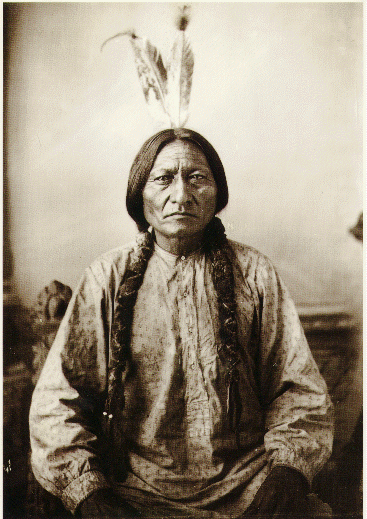
Chief Sitting Bull Relations with White Settlers
In relations with the white settlers all the divisions of the Sioux have a similar history. The Sioux became friendly with the British after the fall of the French power and supported the British against the United States in the American Revolution and (with the exception of one chief, Tohami, also known as Rising Moose) in the War of 1812. The United States concluded treaties with the Sioux in 1815, 1825, and 1851. A portion of the Sioux under Little Crow rose in 1862 and massacred more than 800 settlers and soldiers in Minnesota; this revolt was suppressed but unrest continued.

Crazy Horse
In 1867 a treaty was concluded by which the Sioux gave up a large section of territory and agreed to retire to a reservation in SW Dakota before 1876. The discovery of gold in the Black Hills and the subsequent rush of prospectors brought resistance under the leadership of such chiefs as Sitting Bull, Red Cloud, Rain-in-the-Face, Crazy Horse, American Horse, and Gall. In this revolt occurred the famous last stand by Gen. George Armstrong Custer. The last major conflict fought by the Sioux was the battle of Wounded Knee, Dec. 29, 1890, which resulted in the massacre of over 200 Native Americans.
Native Village Sitting Bull c.1831-1890, Native American chief, Sioux leader in the battle of the Little Bighorn. He rose to prominence in the Sioux warfare against the whites and the resistance of the Native Americans under his command to forced settlement on a reservation led to a punitive expedition. In the course of the resistance occurred the Native American victory on the Little Bighorn, where George Armstrong Custer and his men were defeated and killed on June 25, 1876. Sitting Bull and some of his followers escaped to Canada, but returned (1881) on a promise of a pardon and were settled on a reservation. In 1885 he appeared in Buffalo Bill's Wild West Show, but his championship of the Native American cause was not at an end. He encouraged the Sioux to refuse to sell their lands, and he advocated the ghost dance religion. He was killed by Native American police on a charge of resisting arrest. He was buried in North Dakota, but in 1954 his remains were removed to South Dakota. See J. M. Carroll, ed., The Arrest and Killing of Sitting Bull: A Documentary (1986); biographies by Stanley Vestal (rev. ed. 1957, repr. 1972); A. B. Adams (1973); K. B. Smith (1987).
Sioux Burial Red Cloud 1822-1909, Native North American chief, leader of the Oglala Sioux. He led the Native American warfare against the establishment of the Bozeman Trail. The Fetterman Massacre in 1866 led to partial abandonment of the trail. Red Cloud's continual hostility led the government finally to abandon completely (1868) the trail and the forts built to protect it. After signing a treaty he lived in peace with the whites, although he was later charged with duplicity in encouraging hostile Native Americans. Deposed as chief in 1881, he lived thereafter in retirement on the Pine Ridge Reservation in South Dakota. See J. C. Olson, Red Cloud and the Sioux Problem (1965).
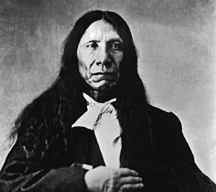
As chief of the Oglala Sioux native American group, in the 1860s Red Cloud fought to prevent United States occupation of what are now parts of Wyoming, Montana, and South Dakota.
Gall
Sun Dance and Dog Feast

General George Armstrong Custer - 7th Cavalry Crazy Horse d. 1877, Native American chief of the Oglala Sioux. He was a prominent leader in the Sioux resistance to the encroachment of whites in the mineral-rich Black Hills. When Crazy Horse and his people refused to go on a reservation, troops attacked (March 17, 1876) their camp on Powder River. The great war chief was victorious in that battle as well as in his encounter with Gen. George Crook on the Rosebud River (June 17). Crazy Horse joined Sitting Bull and Gall in defeating George Armstrong Custer at the battle of the Little Bighorn (June 25). In Jan., 1877, Gen. Nelson Appleton Miles attacked his camp, and Crazy Horse and his followers spent the remainder of the winter in a state of near starvation. The group, numbering about 1,000, finally surrendered at the Red Cloud agency in May. Imprisoned because of a rumor that he was planning a revolt, Crazy Horse was stabbed to death with a bayonet when attempting to escape. His bravery and skill were generally acknowledged, and he is revered by the Sioux as their greatest leader. See biographies by Mari Sandoz (1942, repr. 1955) and E. A. Brininstool (1949).
Crazy Horse
Story of a Brave Sioux Leader
A very great vision is needed and the man who has it must follow it as the eagle seeks the deepest blue of the sky ... we preferred hunting to a life of idleness on our reservations. At times we did not get enough to eat and we were not allowed to hunt. All we wanted was peace and to be left alone. Soldiers came and destroyed our villages. Then Long Hair (Custer) came...They say we massacred him, but he would have done the same to us. Our first impulse was to escape but we were so hemmed in we had to fight.
Crazy Horse, as remembered by Charles A. Eastman
Crazy Horse, Tashunkewitko of the western Sioux, was born about 1845. Killed at Fort Robinson, Nebraska in 1877, he lived barely 33 years.
As a boy, Crazy Horse seldom saw white men. Sioux parents took pride in teaching their sons and daughters according to tribal customs. Often giving food to the needy, they exemplified self-denial for the general good. They believed in generosity, courage, and self-denial, not a life based upon commerce and gain.
One winter when Crazy Horse was only five, the tribe was short of food. His father, a tireless hunter, finally brought in two antelope. The little boy rode his pony through the camp, telling the old folks to come for meat, without first asking his parents. Later when Crazy Horse asked for food, his mother said, "You must be brave and live up to your generous reputation."
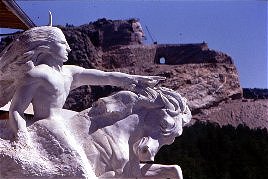
Crazy Horse loved horses, and his father gave him a pony when he was very young. He accompanied his father on buffalo hunts, holding the pack horses while the men chased the buffalo. At the time the Sioux had few guns and the hunting was mostly done with bow and arrows.
When he was 12, Crazy Horse was with his little brother, when they were startled by the growl of a bear. Young Crazy Horse pushed his brother up into a tree and sprang to his horse. Once he controlled the runaway horse he returned, yelling and swinging his lariat over his head and the bear finally turned and ran.
Sioux boys often waited in the field after a buffalo hunt until sundown. Then they would enjoy a mimic hunt and lasso the calves, driving them into camp. Once the larger boys dared Crazy Horse to ride a bull calf. He hung on a good distance, followed by the other boys on their ponies.
When he was 16, Crazy Horse joined his first war party. He followed a Sioux warrior, named Hump, near the front of the charge. When Hump's horse was shot from under him, Crazy Horse leaped from his horse, helped him up in the saddle, and carried him to safety with the enemy in hot pursuit. Hump, then at the height of his own career, pronounced Crazy Horse the coming warrior of the Teton Sioux.
It was customary for young men to spend much time in prayer and solitude, fasting in the wilderness --typical of Sioux spiritual life which has since been lost in the contact with a material civilization.
Hump and Crazy Horse became close friends, in spite of the difference in age. Men called them "the grizzly and his cub." Again and again the pair saved the day in skirmishes with neighboring tribes.
Crazy Horse often pursued the enemy into their stronghold, then instead of killing them, he simply struck them with a switch, showing his disdain. When a party of young warriors led by Crazy Horse pursued a herder to the very gate of the stockade, fire from the garrison killed his young brother.
Once Crazy Horse came back from a winter buffalo hunt with ten buffalo tongues which he sent to the council lodge. Another day killed ten buffalo cows with his bow, and unsuccessful hunters were made happy by his generosity.
Crazy Horse was 21 when all the Teton Sioux chiefs met in council to determine their future policy toward the invader. They once thought that the country was wide, and that the white traders should be made welcome. They had permitted the Oregon Trail, but now to their astonishment forts were built in their territory.
Most of the chiefs advocated a strong resistance. A few still desired to live in peace and were willing to make another treaty. Among them were White Bull, Two Kettle, Four Bears, and Swift Bear. Even Spotted Tail decided they should defend their rights and territory by force. Attacks were to be made upon the forts within their country and on every trespasser.
Crazy Horse was chosen to lead the attack on Fort Kearny. Sitting Bull looked to him as a principal war leader; even the Cheyennes acknowledged this. During the next 10 years of defensive war, he carried out the council's decisions and was frequently consulted by the older chiefs.
Like Osceola, he rose suddenly; like Tecumseh he was impatient for battle; like Pontiac, he fought on while his allies were suing for peace, and like Grant, he was a man of deeds and not of words.
Early in the year 1876, word came from Sitting Bull that all the roving bands would converge in Montana for summer feasts and conferences. Conflicting rumors came from the reservation -- Either the U.S.Army would fight the Sioux to a finish or another commission would be sent out to treat with them.
The Indians came together forming a series of encampments stretching a few miles. In June, scouts reported the advance of troops under General Crook. Crazy Horse was sent with 700 men to attack. They exchanged shots with some Crow scouts, who fled back to Crook's camp to warn him. Again and again Crazy Horse charged with his bravest men in an attempt to bring the troops into the open. He returned to camp disappointed; Crook later retreated.
If Crook had kept on as ordered with his 1000 regulars and 200 Crow and Shoshone scouts, he would have intercepted Custer. The war with the Sioux would have ended right there. Instead, he fell back upon Fort Meade, eating his horses on the way, in a country full of game, for fear of Crazy Horse and his braves!
The Indians now crossed the divide between the Tongue and the Little Big Horn, where they felt safe from pursuit. On June 25, 1876, their great camp was scattered for more than three miles along the river bottom with five circular rows of teepees, up to a mile and a half in circumference.
Crazy Horse was a member of the "Strong Hearts" and the "Tokala" or Fox lodge. He was watching a game of ring-toss when warned of approaching troops. Many men were out on the daily hunt; women and children reacted in confusion. In spite of being caught in the midst of their festivities, the Sioux and the Cheyennes responded quickly.
Crazy Horse saddled his favorite war pony and started toward the south end of the camp, when a fresh alarm came from the opposite direction. Looking up, he saw Custer's force on the bluff directly across the river, planning to attack the camp from both ends at once. Knowing that Custer could not ford the river at that point, he led his men north to the ford to cut him off. This wild general of the plains had outwitted a brilliant leader of the Civil War and ended at once his military career and his life.
Crazy Horse snatched his most famous victory out of frightful peril, for the Sioux could not know how many were behind Custer. It must have seemed as if the Indians rose up from the earth to overwhelm them. Closing in from three sides, they fought until not a white man was left alive. The approach of General Terry compelled the Sioux to break camp and scatter in different directions.
While Sitting Bull was pursued into Canada, the Cheyennes were undisturbed until winter, when the army surprised them. Crazy Horse was not far off. His name was held in respect. Delegations of friendly Indians were sent to him, to urge him to come in to the reservation, promising a full hearing and fair treatment.
For some time he held out. The rapid disappearance of the buffalo meant near starvation for his people. In July 1877, he was convinced to come to Fort Robinson with several thousand Ogallala and Minne-conwoju Sioux, with the distinct understanding that the government would hear grievances.
General Crook and some Indian scouts planned a conspiracy against Crazy Horse. Crazy Horse decided to take his critically ill wife to her parents, whereupon his enemies circulated the story that he had fled. After a party of scouts threatened him, he went to call on agent Captain Lea, accompanied by an imposing escort of warriors on horseback.
The captain urged him to report at army headquarters to explain himself and correct false rumors, and furnished him with a wagon and escort. Some said that he went back under arrest, but others say he went of his own accord, either suspecting no treachery or determined to defy it.
When he reached the military camp, he was unarmed except for the knife carried for ordinary uses by women and men. He walked toward the guardhouse, when his cousin suddenly turned back exclaiming, "They will put you in prison!"
"Another white man's trick! Let me die fighting!" cried Crazy Horse. He tried to free himself and draw his knife, but both arms were held fast. While he struggled, a soldier thrust him through with his bayonet from behind. His old father sang the death song over him and afterward carried away the body. They hid it somewhere in the Bad Lands, his resting place to this day.

Crazy Horse
White Buffalo Dance The Sioux Today
Today they live mainly on reservations in Minnesota, Nebraska, North Dakota, South Dakota, and Montana; they number over 100,000. In Feb., 1973, about 200 Native American supporters, mostly Sioux, of the American Indian Movement seized control of the hamlet of Wounded Knee, S.Dak., demanding U.S. Senate investigations of Native American conditions. The occupation lasted 70 days, during which about 300 persons were arrested by Federal agents.
For generations the Lakota people have survived the extremes of their environment. Whether as hunters on the plains of North America or as captives on bleak reservations, they have persevered to maintain their own ways of life and expression.
Today, numerous difficulties exist for the approximately 100,000 Lakota in and around the reservations of the Dakotas. Endemic poverty grips the area, a fact made more ironic by the enormous wealth forcibly extracted from their lands by Euro-American settlers. Health issues such as diabetes and alcoholism continue to take a tremendous toll and contribute to one of the shortest life expectancies of any group in the country. Finally, the effects of government-mandated boarding schools have also nearly obliterated the Lakota language and the last generation of speakers must now struggle against incredible odds to reverse its demise.
In the face of this tragedy, the Lakota continue to honor the ancestors who struggled for their way of life and they work towards the recognition of negotiated treaty obligations and the respect for their human rights.
The Lakota language expresses the Lakota worldview and culture more profoundly than any other means of communication. Ideas and thoughts embedded and expressed in Lakota form the core of their values and conceptual universe. Unfortunately, the use of the Lakota language is in near irreversible decline. Generations of have been forced to speak English in the boarding school system and today the language is used generally only by elders. For the Lakota, the loss of their language is tantamount to losing their cultural identity, and they are working hard to prevent its extinction.
In 2002, the Lakota Language Consortium project was initiated and restructured in 2004 to begin publication of a Lakota language textbook series. The project is promising start on the road to Lakota language revitalization.
We are a nonprofit that develops Lakota language revitalization materials for schools in the Dakotas. Our goal is to help train a new generation of speakers through language curricula in the schools and promote Lakota language in the communities.
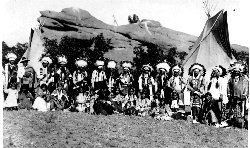
Tribal Leaders
Gall Bibliography
See R. H. Ruby, The Oglala Sioux (1955); G. E. Hyde, A Sioux Chronicle (1956); C. M. Oehler, The Great Sioux Uprising (1959); Kenneth Carley, The Sioux Uprising of 1862 (1961); R. M. Utley, The Last Days of the Sioux Nation (1963); Royal Hassrick, The Sioux (1964); Ethel Nurge, ed., The Modern Sioux (1970); Robert Burnette, The Tortured Americans (1971); E. T. Denig, Five Indian Tribes of the Upper Missouri (1975).
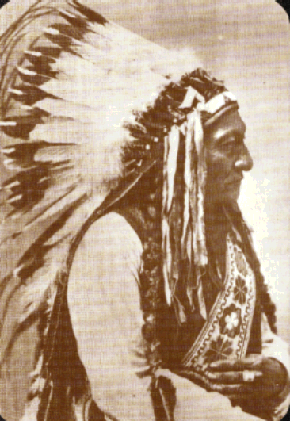
Chief Sitting Bull
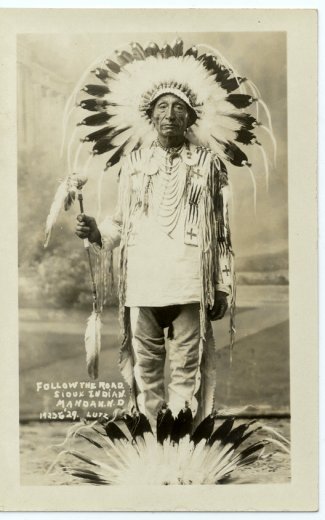
Chief Mandan 1923
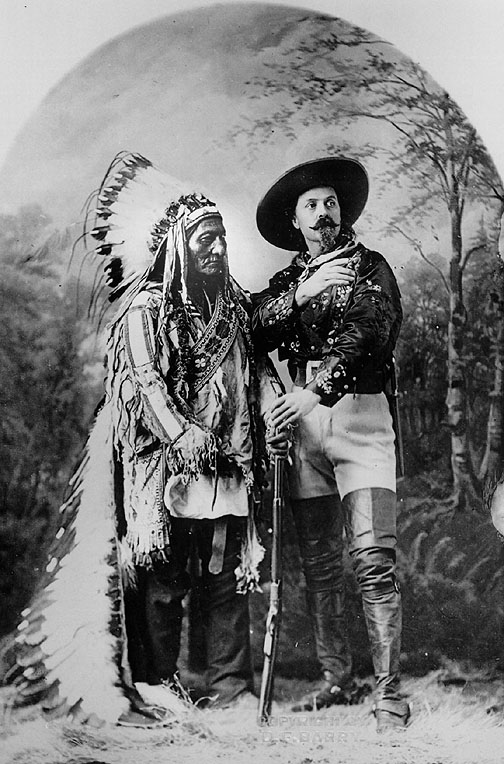
Chief Sitting Bull & Buffalo Bill
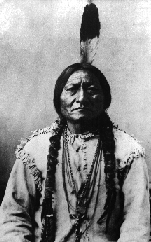
Chief Sitting Bull
American Indian Culture Research Center
A lovely site - the Center's history is given, with links to "Culture,"
"Religion," "Myths," etc. of the Lakota/Dakota Nations and other Native
peoples.
http://www.bluecloud.org/dakota.html
Black Hills Treaty
Scans of the original 1868 treaty (from the National Archives) between the
United States government and the Sioux. The document is shown in three
parts, each large and a bit slow to load. Good picture of Spotted Tail, a
Brule Sioux chief.
http://www.nara.gov/exhall/originals/sioux.html
Dakota Exile
Through the words of Dakota elders and tribal historians, Dakota Exile (a
television documentary) tells of this people's struggle to remain Dakota in
the face of government efforts to destroy their language and culture. There
are two pages of stills from the show and a timeline. The photos take a
while to load but they're worth the wait while you read the accompanying
text.
http://www.ktca.org/dakota/exile.htm
Dakota Tamakoce Singers
This website "offers the largest library of traditional Dakota songs. We
also offer other information about various aspects of the Dakota culture and
music." [Brian Freeman]
You'll need RealPlayer to enjoy the audio files.
http://turtletrack.org/tamakoce
Dakota/Lakota Indian Homepage
Lots of information about the Dakota and Lakota Indians. Midway through the
page are treaties between these tribes and the U.S. government. There is
also essay with many references.
http://maple.lemoyne.edu/%7Ebucko/lakota.html
Explorer Reports
Just a brief history of this nation. Be sure to scroll sideways, though.
There's another half-screen width and length, too, that you don't see
otherwise.
http://www.chaos.com/Travel/TransAmerica/his7reports.html
Facts About Pine Ridge
The reality of life on this reservation is shocking.
http://www.redcloudschool.com/rez.htm
Guide to the Great Sioux Nation
A webpage with maps and images and oodles of good information for each tribe
within the Sioux Nation.
http://www.state.sd.us/state/executive/tourism/sioux/sioux.htm
History of Oglala Dakota Sioux
From 1794 on to the arrival of the white man, these Sioux ruled the Black
Hills of Dakota. Read the story. Meet a few of their greatest chiefs.
http://www.geocities.com/Athens/Acropolis/3976/Leaders1.html
Imaging and Imagining the Ghost Dance
An article (with illustrations -- photos and paintings) describing the
Lakota Ghost Dance during the years 1891-93.
http://php.indiana.edu/~tkavanag/visualb.html
Lakota Astronomy
Vision quests, Medicine Wheels, and "the Fallen Star" are all part of what
you'll find here. While it's been said that the Sioux didn't have much of an
interest in
astronomy, this site's author offers facts that would indicate otherwise.
http://www.clas.ufl.edu/users/seeker1/scholarly/lakota.htm
Lakota Page
A printed version of a talk given by this site's author, dealing with the
various bands of the Sioux nation, past and present. Follow the links for
further information.
http://members.aol.com/bbbenge/page6.html
Lakota Sioux
A large website with sections concerning history, art, music and dance,
language, movies, and organizations. The Sioux, then and now... here you go!
http://www.blackhills-info.com/lakota_sioux/
Lakota Star Knowledge
A complicated site to wade through, with diagrams showing the Lakota star
map and what I think is supposed to represent a mirror map for ceremonies
held in the Black Hills. There are some interesting things here, but it's
hard work to dredge them up.
http://indy4.fdl.cc.mn.us/~isk/stars/startabs.html
Lakota Teaching Project
Another excellent site here! Leave yourself plenty of time to check it all
out.
http://www.tiac.net/users/lakota/
Lakota Wowapi Oti Kin
That translates as "Lakota Information Home Page". A large site with lots of
information of all kinds about this Plains tribe, including maps, language,
culture, tribes, and Wounded Knee.
http://maple.lemoyne.edu/~bucko/lakota.html
Morning Star's Page
The webmistress is the great-granddaughter of Red Cloud, famous Chief of the
Oglala Sioux. She offers some good information, entertaining stories, a chat
room, and other items of interest related to her people.
http://207.79.8.68/wicu/
Old Indian Days
Some short stories, fiction, but full of interesting facts about the daily
lives and customs of the Sioux. An entertaining way to learn. Written by
Charles Eastman, born in 1858, a Santee Indian who became a physician and
attended the Sioux at Wounded Knee.
http://etext.lib.virginia.edu/cgibin/browse-mixed?id=EasDays&tag=public&imag
es=images/modeng&data=/lv1/Archive/eng-parsed
Places in the WEST - The Black Hills
Not all the links lead to the Sioux (Lakota) but most do. You'll learn about
the surrender of Sitting Bull and how the gold rush affected these people,
for starters. Just follow the in-text links.
http://www3.pbs.org/weta/thewest/wpages/wpgs300/3blkhlls.htm
Sioux Heritage
"Wan LA wa!" Don't be puzzled. It's the Lakota word for "look!" and this is
definitely a good site at which to look. On the Lakhota Words pages you are
given 11 categories of everyday words, with a pronunciation guide and
sometimes an audio file, in .wav format. You can learn about contemporary
Sioux culture or send a postcard to a friend from this site.
http://lakhota.com/default.htm
Sisseton Wahpeton Sioux Tribe
The "History and Culture" section of this site is particularly informative,
covering the topics of history, family and political structure, and housing.
The small, black and white photos are clickable if you want to see a larger
image.
http://swcc.cc.sd.us/homepage.htm
Sitting Bull and the Mounties
What a wonderful account of the time Sitting Bull moved his people to Canada
to avoid further hostilities with the American army. You'll quickly see that
even in those days, the media and politicians had a knack for being a very
big problem in the lives of the common man.
http://www.historynet.com/WildWest/articles/1998/0298_text.htm
Sota Iya Ye Yapi
This weekly, online paper carries current news of interest to the
Sisseton-Wahpeton Sioux Tribe. There's a culture section, as well, which
compares Indian to non-Indian values and lifestyle.
http://www.earthskyweb.com/sota.html
South Dakota Indian Tribes
Click on the interactive map here (or on the text links) which takes you to
pages about the eight Sioux reservations in South Dakota. From some you'll
get information about tourism, contact people, numbers, history, etc.
http://indy4.fdl.cc.mn.us/~isk/maps/dakotas/sd.html
Tribute to Oglala Sioux
General information here and many links, both onsite and off. There are
lists of the three branches of Sioux, the tribes, the bands, and a
reservations map.
http://www.geocities.com/Athens/Acropolis/3976/Hawk.html
Voices of the Wintercount
"...original, unedited comments by real people, taking a stand for their way
of life". Topics include a 1952 bill that would allow government agents "to
shoot Indians on
sight" and the buffalo slaughter of the 1890s.
http://www.wintercount.org/
Wife of Jack Red Cloud
A brief but interesting diversion for you. This is a 1905 photograph of
Chief Red Cloud's daughter-in-law,
who, according to the tribe's taboo, could never look directly
at him.
http://rth.netgate.net/walkingshield/gallery/wife_jack.html
Wounded Knee Site Index...
Topics include a first-hand account of Wounded Knee by a survivor. What
happened? The story is told from the Native perspective.
http://www.dickshovel.com/WKmasscre.html
Return to
NativeAmericans.com
|
|
|
|
|
|
 Native American Nations
Native American Nations
